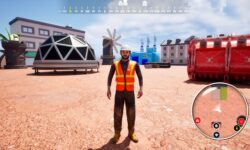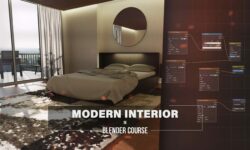Unreal Engine 5 – Complete Beginner’s Course (2023) by Pixel Helmet
Release date:2023
Author:Pixel Helmet
Skill level:Beginner
Language:English
Exercise files:Yes
For the final project of the “Imaginary Places: Draw, Paint, and Digitize on Photoshop” course, you will be encouraged to use the skills and techniques you have learned throughout the course to create your own unique imaginary place. Here are the steps you can follow:
- Gather Inspiration: Take the time to gather inspiration from your surroundings, whether it’s through sketchbook sketches, textures, or experiences. Observe the details of the world around you, such as how light falls on objects, the colors of the sun, and the shadows created. Use this inspiration to fuel your creativity and come up with ideas for your imaginary place.
- Create a Mood Board: Use the inspiration you’ve gathered to create a mood board. This can be a collage of images, sketches, textures, and other visual elements that represent the mood, atmosphere, and style you want to convey in your imaginary place. Keep track of your progress with different pictures of each step and explain the choices you’ve made along the way.
- Develop Textures: Use the abstract nature of creating textures to spark new ideas for your imaginary place. Experiment with different techniques and tools in Photoshop to create unique textures that can be used in your illustrations. Create a folder to store these textures, as they can be used in your future illustrations as well.
- Infuse Your Imagination: Once you have gathered inspiration and created textures, it’s time to infuse your imagination into your project. Use the skills and techniques you have learned in the course, such as drawing, painting, and digitizing on Photoshop, to bring your imaginary place to life. Be creative and experiment with different styles, colors, and compositions to make your project truly unique.
- Document Your Process: As you work on your final project, document your process by taking pictures and explaining the choices you’ve made along the way. This will not only help you track your progress but also provide insight into your creative process, which can be helpful if you need advice or guidance from your instructor.
- Create a Unique Project: Whether you choose to finish the illustration you started during the course tasks or start a brand new project, make sure to create a unique project that reflects your artistic style and vision. Don’t be afraid to take risks and push your creative boundaries to make your imaginary place come to life in a way that is truly your own.
By following these steps and using the skills and techniques you’ve learned in the course, you will be able to create a unique imaginary place that showcases your creativity and artistic abilities. Don’t forget to have fun and enjoy the process of bringing your imagination to life on Photoshop!
In the course “Learn Game Development Using Unreal Engine 5,” you will learn the following:
- Game Development with Unreal Engine 5: You will learn the basics of game development using Unreal Engine 5, one of the most popular and powerful game engines in the industry. You will learn how to navigate the Unreal Engine interface, create and edit game levels, and work with various game development tools and features.
- Environment Creation: You will learn how to create realistic-looking environments for games to take place in. This includes creating landscapes, adding foliage, placing props, and setting up lighting to create immersive and visually appealing game worlds.
- Custom Inputs and Movements: You will learn how to define custom inputs and movements to control characters in your game. This includes setting up controls for character movement, camera manipulation, and interactions with objects in the game world.
- Scripting Logic: You will learn how to script logic using Unreal Engine’s visual scripting system, Blueprint. You will be able to define gameplay mechanics, create interactive objects, and implement game rules without needing to write code. This makes game development accessible to those who may not have a background in programming.
- Game Design Principles: You will learn the principles of game design, including level design, game mechanics, and gameplay flow. You will understand how to create engaging and enjoyable games that provide a meaningful experience for players.
- Testing and Debugging: You will learn how to test and debug your games using Unreal Engine’s built-in tools. This includes identifying and fixing bugs, optimizing performance, and ensuring that your game is playable and enjoyable for players.
By the end of the course, you will have a solid foundation in game development using Unreal Engine 5 and be able to create your own games with realistic environments, custom inputs and movements, and scripted logic for gameplay mechanics. You will also understand the principles of game design and be able to create games that provide an enjoyable experience for players.





 Channel
Channel






Hi, can you upload this course please!, I will be very grateful.